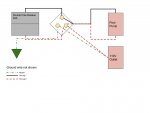Bought a new house last August that has a pool. This is our first time owning a pool. Pool is in decent shape, and all the equipment works, but the plumbing is a functional and cosmetic mess, and the pump timer is broken. I'm pretty handy, so decided to tackle fixing everything myself.
While planning this out, I started to look at SVRS options, as our pool inspector had recommended installing one. While Googling, I found that Hayward and Pentair make pumps that are variable speed (allegedly more efficient), include a digital timer, and include SVRS. These pumps run about $1200.
When you consider an add-on SVRS is $500 and a new timer is $100, you're "only" paying $600 for a brand new pump, far simpler install, and alleged energy efficiency. BUT...
- These pumps are 220V; I'm currently wired for 110V
- These pumps are 3HP; I currently have a 1HP pump that is sufficient
So, first, my pump questions:
- Is a 3HP variable speed pump an appropriate solution to replace a 1HP single speed pump? Overkill? We don't have any water features or anything fancy; just a skimmer, sidewall suction, and two returns.
- Are these pumps really that much more energy efficient? Physics says work is work, and if I need to filter the entire pool (29K gallons) each day, it will take roughly the same electricity whether I run a 1HP pump for 10 hours, a 3HP pump for 3 hours, or a 30HP pump for 15 minutes (gross generalization, but hopefully you get what I'm hinting at).
- Any other benefits besides efficiency of having a variable speed pump?
Now, my electrical questions (I also posted these on an electrical forum):
I currently have two 20A, 110V electrical circuits run out to my pool equipment area. The circuit breakers for each of these are right on top of one another. The wiring was done with 12/3, so there is only one neutral between the two circuits. I can easily convert this to 220V by replacing the individual breakers with a 20A double pole breaker. However...I also need 110V on the equipment pad to run the vacuum.
I've attached a diagram of what I'm thinking about doing. If I have my electrical theory right, the two hot legs have 220V potential to each other, and if I connect one hot leg to neutral, it will have 110V potential to ground.
Questions are:
1. Is this legal?
2. Is this safe?
3. If I overload the 110V outlet, either with the pump on or off, will it trip the double pole breaker?
4. What happens if I am running the pump and have something plugged into the 110V outlet at the same time? Will it cause pump problems due to a lower voltage in one leg than the other?
Thanks!

While planning this out, I started to look at SVRS options, as our pool inspector had recommended installing one. While Googling, I found that Hayward and Pentair make pumps that are variable speed (allegedly more efficient), include a digital timer, and include SVRS. These pumps run about $1200.
When you consider an add-on SVRS is $500 and a new timer is $100, you're "only" paying $600 for a brand new pump, far simpler install, and alleged energy efficiency. BUT...
- These pumps are 220V; I'm currently wired for 110V
- These pumps are 3HP; I currently have a 1HP pump that is sufficient
So, first, my pump questions:
- Is a 3HP variable speed pump an appropriate solution to replace a 1HP single speed pump? Overkill? We don't have any water features or anything fancy; just a skimmer, sidewall suction, and two returns.
- Are these pumps really that much more energy efficient? Physics says work is work, and if I need to filter the entire pool (29K gallons) each day, it will take roughly the same electricity whether I run a 1HP pump for 10 hours, a 3HP pump for 3 hours, or a 30HP pump for 15 minutes (gross generalization, but hopefully you get what I'm hinting at).
- Any other benefits besides efficiency of having a variable speed pump?
Now, my electrical questions (I also posted these on an electrical forum):
I currently have two 20A, 110V electrical circuits run out to my pool equipment area. The circuit breakers for each of these are right on top of one another. The wiring was done with 12/3, so there is only one neutral between the two circuits. I can easily convert this to 220V by replacing the individual breakers with a 20A double pole breaker. However...I also need 110V on the equipment pad to run the vacuum.
I've attached a diagram of what I'm thinking about doing. If I have my electrical theory right, the two hot legs have 220V potential to each other, and if I connect one hot leg to neutral, it will have 110V potential to ground.
Questions are:
1. Is this legal?
2. Is this safe?
3. If I overload the 110V outlet, either with the pump on or off, will it trip the double pole breaker?
4. What happens if I am running the pump and have something plugged into the 110V outlet at the same time? Will it cause pump problems due to a lower voltage in one leg than the other?
Thanks!


